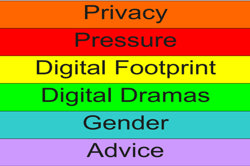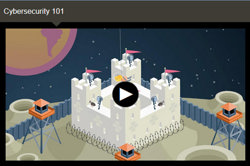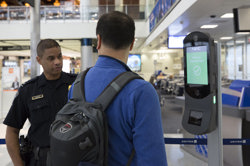When I post something online how permanent is it?
Students engage in a photo rip up activity to emphasize the permanency of online information, they explore factor trees, doubling and line graphs through the lens of sharing information, and they collaboratively develop a set of protocols around sharing information online.
Additional details
| Year band(s) | 5-6, 7-8 |
|---|---|
| Content type | Lesson ideas |
| Format | Web page |
| Core and overarching concepts | Privacy and security |
| Australian Curriculum Digital Technologies code(s) |
AC9TDI6P07
Select and use appropriate digital tools effectively to create, locate and communicate content, applying common conventions
AC9TDI6P08
Select and use appropriate digital tools effectively to share content online, plan tasks and collaborate on projects, demonstrating agreed behaviours
AC9TDI6P10
Explain the creation and permanence of their digital footprint and consider privacy when collecting user data
AC9TDI8P11
Select and use a range of digital tools efficiently, including unfamiliar features, to create, locate and communicate content, consistently applying common conventions
AC9TDI8P12
Select and use a range of digital tools efficiently and responsibly to share content online, and plan and manage individual and collaborative agile projects
AC9TDI8P14
Investigate and manage the digital footprint existing systems and student solutions collect, and assess if the data is essential to their purpose |
| Keywords | Noline, Protocols, Share information, Graphs, Doubling, Digital Citizenship, Inclusive education, Fine motor skills, limited motor skills, abstract thinking, Inclusive education, disability, disabilities |
| Integrated, cross-curriculum, special needs | Mathematics, Digital Literacy |
| Organisation | ESA |
| Copyright | Creative Commons Attribution 4.0, unless otherwise indicated. |
Related resources
-

eSafety Commissioner: Video and resource library
Online safety resources for secondary schools supported by lesson plans and multimedia resources. Use the filters to find tailored resources suitable for your classroom needs.
-

Digital Citizenship Unplugged
This site provides a structured lesson plan to teach Digital Citizenship to primary-aged students.
-

Growing Up Digital
This site provides a multitude of lesson plans aimed to cover a variety of issues that can arise from the use of digital technology, and ways to effectively prevent or overcome them.
-

NovaLab: Cyber security
These cyber security short animated videos each have a quick quiz to complete. The videos cover a basic intro into cyber security, hacking and privacy, cyber codes and there is a game too for students to apply their understandings.
-

AI image recognition - exploring limitations and bias
A hands-on activity to practise training and testing an artificial intelligence (AI) model, using cartoon faces, including a discussion about sources of potential algorithmic bias and how to respond to these sources.
-

Detecting phishing scams
In this learning sequence, students work in groups to create and analyse common phishing scams, gaining a deeper understanding of the techniques used by scammers. They then develop rules for artificial intelligence (AI) algorithms to detect these scams, promoting critical thinking about cybersecurity and online safety.
